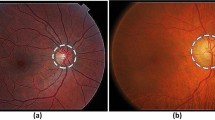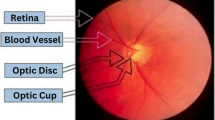Abstract
Artificial Intelligence has shown significant enhancement recently, in many fields, especially in pattern recognition in computer vision and hence in medical diagnosis, wherein highly accurate automated diseases diagnosis has now become feasible. Artificial Intelligence methods, especially based on deep learning are very powerful and have got huge training and learning potential. These methods are growing from strength to strength and far exceeding the performance of traditional methods. The deep learning has proved to be highly efficient and accurate especially when balanced and large training data is available. This chapter provides an overview of various Artificial Intelligence based techniques for detection of the second-largest disease which causes blindness, that is, glaucoma. The chapter begins with the introduction of glaucoma and the various important parameters required for its accurate diagnosis. The later sections introduce various traditional Machine learning based techniques, followed by Deep learning based techniques including the Transfer learning and Ensemble learning based techniques in use for automated glaucoma detection, along with their advantages and drawbacks. This chapter also exposes readers to original and genuine data of perimetry and OCT tests.
Access this chapter
Tax calculation will be finalised at checkout
Purchases are for personal use only
Similar content being viewed by others
References
Tham YC, Li X, Wong TY, Quigley HA, Aung T, Cheng CY (2014) Global prevalence of glaucoma and projections of glaucoma burden through 2040—a systematic review and meta-analysis. J Ophthalmol 121(11):2081–2090
Khalil T, Khalid S, Akram MU, Jameel A (2017) An overview of automated glaucoma detection. In: IEEE computing conference
Kaur P, Khosla PK (2019) Comparative study of recent automated glaucoma detection techniques using color fundus images. Int J Innov Technol Explor Eng
Ismael Cordero, National Center for Biotechnology Information. https://www.ncbi.nlm.nih.gov/pmc/articles/PMC4322748/. Accessed 29 June 2019
Draeger J (1967) Principle and clinical application of a portable applanation tonometer, investigative ophthalmology and visual science. ARVO J
American Optometric Association, “Glaucoma”. https://www.aoa.org/patients-and-public/eye-and-vision-problems/glossary-of-eye-and-vision-conditions/glaucoma. Accessed 18 June 2019
Meng S-H, Turpin A, Lazarescu M, Ivins J (2005) Classifying visual field loss in glaucoma through baseline matching of stable reference sequences. In: Proceedings of the fourth international conference on machine learning and cybernetics, Guangzhou
Chan K, Lee T-W, Sample PA, Goldbaum MH, Weinreb RN, Sejnowski TJ (2002) Comparison of machine learning and traditional classifiers in glaucoma diagnosis. IEEE Trans Biomed Eng
Yousefi S, Goldbaum MH, Balasubramanian M, Medeiros FA, Zangwill LM, Liebmann JM, Girkin CA, Weinreb RN, Bowd C (2013) Learning from data—recognizing glaucomatous defect patterns and detecting progression from visual field measurements. In: IEEE 13th international conference on data mining
Ceccon S, Garway-Heath DF, Crabb DP, Tucker A (2014) Exploring early glaucoma and the visual field test: classification and clustering using Bayesian networks. IEEE J Biomed Health Inform 18(3)
Jonas JB, Gusek GC, Naumann GO (1988) Optic disc, cup and neuroretinal rim size, configuration and correlations in normal eyes. Invest Ophthalmol Vis Sci 29:1151–1158
Ruengkitpinyo W, Kongprawechnon W, Kondo T, Bunnun P, Kaneko H (2015) Glaucoma screening using rim width based on ISNT rule. In: IEEE 6th international conference of information and communication technology for embedded systems (IC-ICTES)
Tatham AJ, Weinreb RN, Zangwill LM, Liebmann JM, Girkin CA, Medeiros FA (2013) The relationship between cup-to-disc ratio and estimated number of retinal ganglion cells. Investig Ophthalmol Vis Sci
Nyul LG (2009) Retinal image analysis for automated glaucoma risk evaluation. Proc SPIE: Med Imaging Parallel Process Images Optim Tech 7497:1–9
Jakirlic N (2016) Optic nerve evaluation in glaucoma. California Optometric Association
https://www.sciencedirect.com/topics/medicine-and-dentistry/fundus-photography. Accessed 30 June 2019
University of British Columbia, Department of Ophthalmology and Visual Sciences. https://ophthalmology.med.ubc.ca/patient-care/ophthalmic-photography/color-fundus-photography/. Accessed 30 June 2019
Remidio. https://www.remidio.com/fop.php. Accessed 30 June 2019
Coburntechnologies. https://www.coburntechnologies.com/2016/04/12/non-mydriatic-fundus-camera/. Accessed 30 June 2019
National Center for Biotechnology Information. https://www.ncbi.nlm.nih.gov/pmc/articles/PMC6543857/. Accessed 28 June 2019
Giardini ME, Livingstone IAT, Jordan S, Bolster NM, Peto T, Burton M, Bastawrous A (2014) A smartphone based ophthalmoscope. In: 36th annual international conference of the IEEE Engineering in Medicine and Biology Society
Lin S-J, Yang C-M, Yeh P-T, Ho T-C (2014) Smartphone fundoscopy for retinopathy of prematurity. Tiwan J Ophthalmol
Bussel II, Wollstein G, Schuman JS (2014) OCT for glaucoma diagnosis, screening and detection of glaucoma progression. Br J Ophthalmol 98(Suppl-2)
Fujimoto JG, Pitris C, Boppart SA (2000) Optical coherence tomography—an emerging technology for biomedical imaging and optical biopsy. J PMC
Du X, Cai Y, Wang S, Zhang L (2016) Overview of deep learning. In: 31st youth academic annual conference of Chinese Association of Automation (YAC)
Pedrycz K, Pedrycz W (eds) Springer handbook of computational intelligence. Springer
Gad AF (2018) Practical computer vision applications using deep learning with CNNs. Apress
Ding B, Qian H, Zhou J (2018) Activation functions and their characteristics in deep neural networks. In: Chinese control and decision conference (CCDC). IEEE
Shanmugamani R. Deep learning for computer vision: expert techniques to train advanced neural networks using TensorFlow and Keras
Bengio Y et al (2012) Representation learning: a review and new perspectives
Gonzalez RC, Woods RE (2001) Digital image processing. Prentice Hall, Englewood Cliffs, NJ
Sargun, Rana SB (2015) A review of medical image enhancement techniques for image processing. Int J Curr Eng Technol
Hasikin K, Isa NAM (2014) Adaptive fuzzy contrast factor enhancement technique for low contrast and non-uniform illumination images. SIViP 8(8):1591–1603
Raghavendra U, Bhandary SV, Gudigar A, Rajendra Acharya U (2018) Novel expert system for glaucoma identification using non-parametric spatial envelope energy spectrum with fundus images. Bio Cybern Biomed Eng 38(1):170–180
D’Acunto M, Benassi A, Moroni D, Salvetti O (2014) Radon transform: image reconstruction and identification of noise and instrumental artifacts. In: 22nd signal processing and communications applications conference. IEEE
Kertész G, Szénási S, Vamossy Z (2017) Application and properties of the radon transform for object image matching. In: IEEE 15th international symposium on applied machine intelligence and informatics
Kublbeck C, Ernst A (2006) Face detection and tracking in video sequences using the modified census transformation. Image Vis Comput 24(6):564–572
Froba B, Ernst A (2004) Face detection with the modified census transform. In: Sixth IEEE international conference on automatic face and gesture recognition
Jo H-W, Moon B (2015) A modified census transform using the representative intensity values. In: International SoC design conference (ISOCC). IEEE
Xizhi Z (2008) The application of wavelet transform in digital image processing. In: IEEE international conference on multi media and information technology
Olkkonen H (2011) Discrete wavelet transforms—biomedical applications. InTech
Agarwal R, Raman B, Mittal A (2015) Hand gesture recognition using discrete wavelet transform and support vector machine. In: 2nd international conference on signal processing and integrated networks (SPIN)
Ghazali KH, Mansor MF, Mustafa MM, Hussain A (2007) Feature extraction technique using discrete wavelet transform for image classification. In: IEEE the 5th student conference on research and development-SCOReD
Kiran SM, Chandrappa DN (2016) Automatic detection of glaucoma using 2-D DWT. Int Res J Eng Technol (IRJET)
Rajandran N (2014) Glaucoma detection using DWT based energy features and ANN classifier (2014)
Kirar BS, Agrawal DK (2017) Empirical wavelet transform based pre-processing and entropy feature extraction from glaucomatous digital fundus images. In: International conference on recent innovations is signal processing and embedded systems. IEEE
Maheshwari S, Pachori RB, Acharya UR (2017) Automated diagnosis of glaucoma using empirical wavelet transform and correntropy features extracted from fundus images. IEEE J Biomed Health Inform 21(3):803–813
Kavya N, Padmaja KV (2017) Glaucoma detection using texture features extraction. In: IEEE 51st asilomar conference on signals, systems, and computers
Salam AA, Khalil T, Usman Akram M, Jameel A, Basit I (2016) Automated detection of glaucoma using structural and nonstructural features. Springerplus
Lagdali S, Rziza M (2017) Higher order spectra in image processing. In: 3rd international conference on advanced technologies, for signal and image processing, ATSI
Mendel JM (1991) Tutorial on higher-order statistics (spectra) in signal processing and system theory. Theoretical results and some applications. Proc IEEE 79(3):278–305
Krizhevsky A et al (2012) Imagenet classification with deep convolutional neural networks. NIPS
Le QV et al (2011) Building high-level features using large scale unsupervised learning. ICML
Chen X, Xu Y, Wong DWK, Wong TY, Liu J (2015) Glaucoma detection based on deep convolutional neural network. In: 37th annual international conference of the IEEE Engineering in Medicine and Biology Society, EMBC
Raghavendra U, Fujita H, Bhandary SV, Gudigar A, Tan JH, Rajendra Acharya U (2017) Deep convolution neural network for accurate diagnosis of glaucoma using digital fundus images, computerized medical imaging and graphics. ScienceDirect (Elsevier) 55:28–41
Gómez-Valverde JJ et al (2019) Automatic glaucoma classification using color fundus images based on convolutional neural networks and transfer learning. Biomed Opt Express 10(2)
de Moura Lima AC, Maia LB, Pereira RMP, Junior GB, de Almeida JDS, de Paiva AC (2018) Glaucoma diagnosis over eye fundus image through deep features. In: 25th international conference on systems, signals and image processing (IWSSIP)
Li A, Wang Y, Cheng J, Liu J (2018) Combining multiple deep features for glaucoma classification. In: IEEE international conference on acoustics, speech and signal processing (ICASSP)
Simonyan K, Zisserman A (2014) Very deep convolutional networks for large-scale image recognition. arXiv:14091556 Cs
Antropova N, Huynh BQ, Giger ML (2017) A deep feature fusion methodology for breast cancer diagnosis demonstrated on three imaging modality datasets. Med Phys 44(10):5162–5171
Liao H (2016) A deep learning approach to universal skin disease classification
Arif Wani M, Bhat FA, Afzal S, Khan AI (2019) Advances in deep learning studies in big data. Springer
Szegedy C, Liu W, Jia Y, Sermanet P, Reed S, Anguelov D, Erhan D, Vanhoucke V, Rabinovich A (2015) Going deeper with convolutions, pp 1–9
Fu H, Cheng J, Xu Y, Zhang C, Wong DWK, Liu J, Cao X (2018) Disc-aware ensemble network for glaucoma screening from fundus image. IEEE Trans Med Imaging
Author information
Authors and Affiliations
Corresponding author
Editor information
Editors and Affiliations
Rights and permissions
Copyright information
© 2020 Springer Nature Singapore Pte Ltd.
About this chapter
Cite this chapter
Kaur, P., Khosla, P.K. (2020). Artificial Intelligence Based Glaucoma Detection. In: Verma, O., Roy, S., Pandey, S., Mittal, M. (eds) Advancement of Machine Intelligence in Interactive Medical Image Analysis. Algorithms for Intelligent Systems. Springer, Singapore. https://doi.org/10.1007/978-981-15-1100-4_14
Download citation
DOI: https://doi.org/10.1007/978-981-15-1100-4_14
Published:
Publisher Name: Springer, Singapore
Print ISBN: 978-981-15-1099-1
Online ISBN: 978-981-15-1100-4
eBook Packages: Intelligent Technologies and RoboticsIntelligent Technologies and Robotics (R0)




